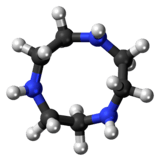1,4,7-Triazacyclononane
1,4,7-Triazacyclononane, known as "TACN" which is pronounced "tack-en," is a cyclic organic compound with the formula C6H12(NH)3.[1] TACN is derived, formally speaking, from cyclononane by replacing three equidistant CH2 groups with NH groups. TACN is one of the oligomers derived from aziridine, C2H4NH. Other members of the series include piperazine, C4H8(NH)2, and the cyclic tetramer 1,4,7,10-tetraazacyclododecane.
 | |
 | |
| Names | |
|---|---|
| IUPAC name
1,4,7-Triazacyclononane | |
| Identifiers | |
3D model (JSmol) |
|
| ChEBI | |
| ChemSpider | |
| ECHA InfoCard | 100.164.887 |
| UNII | |
CompTox Dashboard (EPA) |
|
| |
| |
| Properties | |
| C6H15N3 | |
| Molar mass | 129.2046 g/mol |
Except where otherwise noted, data are given for materials in their standard state (at 25 °C [77 °F], 100 kPa). | |
| Infobox references | |
Synthesis
The ligand is prepared from diethylene triamine as follows by macrocyclization using ethyleneglycol ditosylate.[2]
- H2NCH2CH2NHCH2CH2NH2 + 3 TsCl → Ts(H)NCH2CH2N(Ts)CH2CHH2N(H)Ts + 3 HCl
- Ts(H)NCH2CH2N(Ts)CH2CH2N(H)Ts + 2 NaOEt → Ts(Na)NCH2CH2N(Ts)CH2CH2N(Na)Ts
- Ts(Na)NCHH2CH2N(Ts)CH2CH2N(Na)Ts + TsOCH2CH2OTs + → [(CH2CH2N(Ts)]3 + 2 NaOTs
- [(CH2CH2N(Ts)]3 + 3 H2O → [CH2CH2NH]3 + 3 HOTs
Coordination chemistry
TACN is a popular tridentate ligand. It is threefold symmetric and binds to one face of an octahedron of metalloids and transition metals. The (TACN)M unit is kinetically inert, allowing further synthetic transformations on the other coordination sites. A bulky analogue of TACN, is the N,N',N"-trimethylated analogue trimethyltriazacyclononane.
Illustrative complexes
- Although TACN characteristically coordinates to metals in mid- and high oxidation states, e.g. Ni(III), Mn(IV), Mo(III), W(III), exceptions occur. To illustrate, 1,4,7-triazacyclononane reacts readily with Mo(CO)6 and W(CO)6 to produce the respective air-stable tricarbonyl compounds, [(κ3 -TACN)Mo(CO)3] and [(κ3-TACN)W(CO)3]. Both have an oxidation state of zero. After further reacting with 30% H2O2, the products are [(κ3-TACN)MoO3] and [(κ3-TACN)WO3]. Both of these oxo complexes have an oxidation state of 6. The macrocyclic ligand does dissociate in the course of this dramatic change in formal oxidation state of the metal.
- The complex, [κ3-TACN)Cu(II)Cl2], a catalyst for hydrolytic cleavage of phosphodiester bonds in DNA,[3] is prepared as follows from TACN trihydrochloride:
- TACN·3HCl + CuCl2·3H2O + 3 NaOH → [(κ3-TACN)CuCl2] + 6 H2O + 3 NaCl
- Mn-TACN complexes catalyze epoxidation of alkenes such as styrene using H2O2 as an oxidant in a carbonate buffered methanol solution at a pH of 8.0. These reagents are considered environmentally benign,[4]
- [(κ3-TACN)Mn] + H2O2 + NaHCO3 + (C6H5)C2H3→ [(κ3-TACN)Mn] + 2H2O + CO2 + (C6H5)C2H2O
References
- Chaudhuri, P.; Wieghardt, K. (1987). "The Chemistry of 1,4,7-Triazacyclononane and Related Tridentate Macrocyclic Compounds". In Lippard, Stephen J. (ed.). Progress in Inorganic Chemistry. 35. Hoboken, NJ, USA: John Wiley & Sons, Inc. pp. 329–436. doi:10.1002/9780470166369.ch4. ISBN 9780470166369.
- Wieghardt, Karl; Schmidt, Wilfried; Nuber, Bernhard; Weiss, Johannes (1979). "Darstellung und Struktur des trans-Diaqua-di-μ-hydroxo-bis[(1,4,7-triazacyclononan)cobalt(III)]-Kations; Kinetik und Mechanismus seiner Bildung". Chemische Berichte (in German). 112 (6): 2220–2230. doi:10.1002/cber.19791120629.
- Sibbons, Kevin F.; Shastri, Kirtida; Watkinson, Michael (2006). "The application of manganese complexes of ligands derived from 1,4,7-triazacyclononane in oxidative catalysis". Dalton Transactions (5): 645–661. doi:10.1039/B511331H. PMID 16429167.
- Deal, Kim A.; Burstyn, Judith N. (1996). "Mechanistic Studies of Dichloro(1,4,7-triazacyclononane)copper(II)-Catalyzed Phosphate Diester Hydrolysis". Inorg. Chem. 35 (10): 2792–2798. doi:10.1021/ic951488l.
- Wieghardt, Karl; Schmidt, Wilfried; Endres, Helmut; Wolfe, C. Robert (1979). "Neue μ-Hydroxo-Übergangsmetallkomplexe, II. Darstellung mehrkerniger Komplexe des Chroms(III) mit dreizähnigen Amin-Liganden. Struktur des μ[cis-Dihydroxo(O,O′)-hydroxo(l,4,7-triazacyclononan)chrom(III)]-di-μ-hydroxobis[(1,4,7-triazacyclononan)chrom(III)]-Kations". Chemische Berichte (in German). 112 (8): 2837–2846. doi:10.1002/cber.19791120810.
- Wieghardt, K.; Schmidt, W.; Hermann, W.; Küppers, H.-J. (1983). "Redox potentials of bis(1,4,7-triazacyclononane complexes of some first transition series metals(II,III). Preparation of bis(1,4,7-triazacyclononane)nickel(III) perchlorate". Inorg. Chem. 22 (20): 2953. doi:10.1021/ic00162a037.